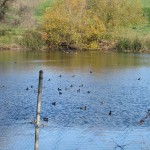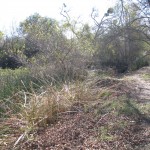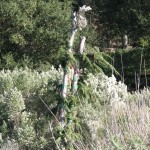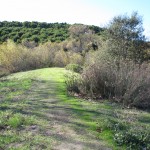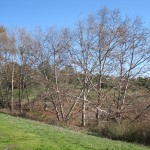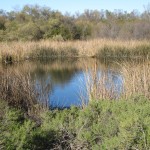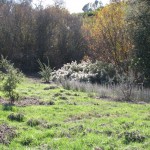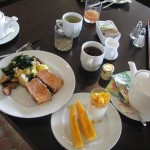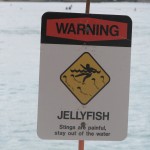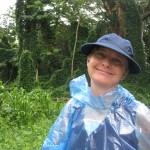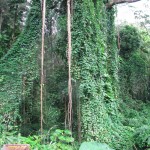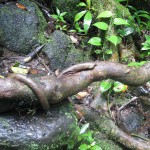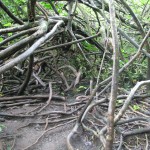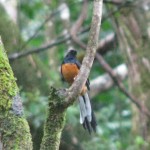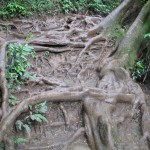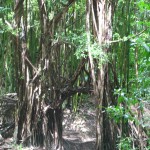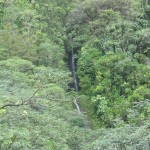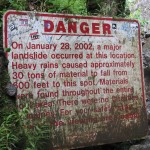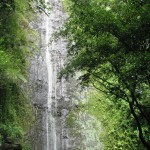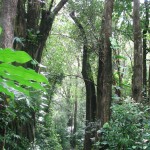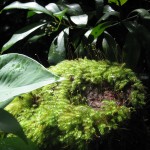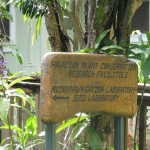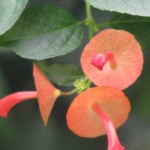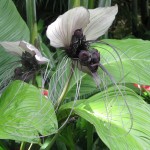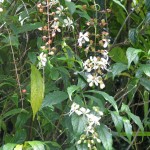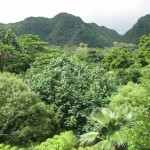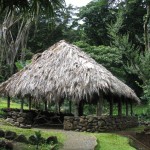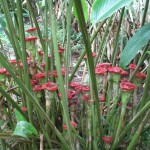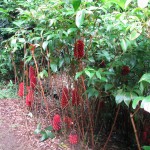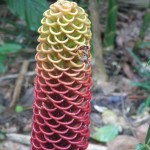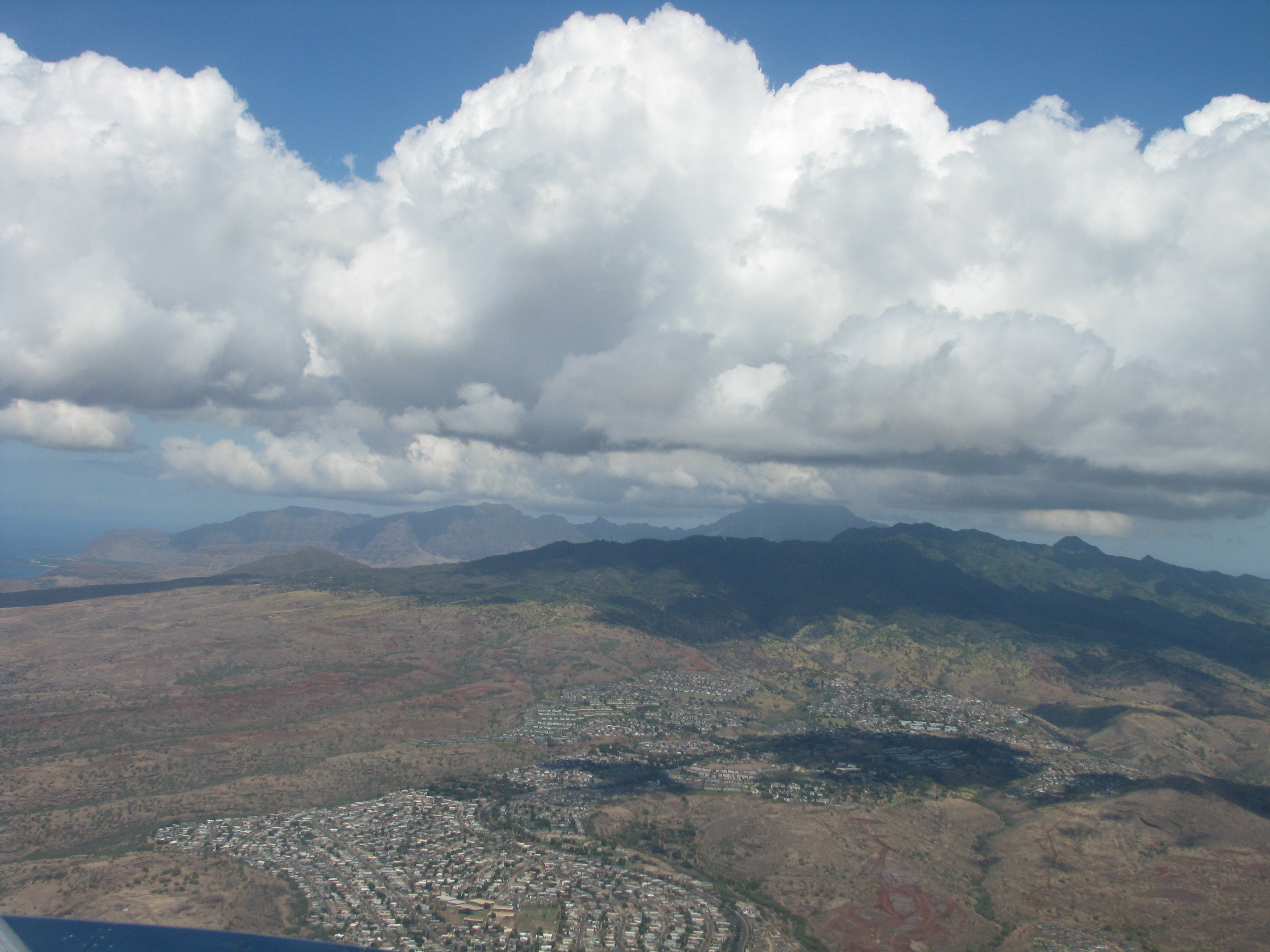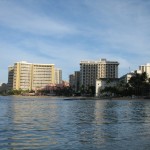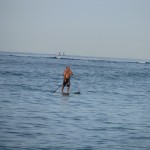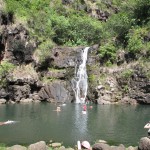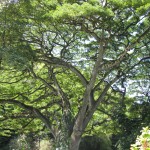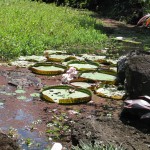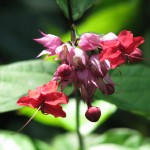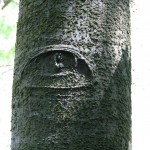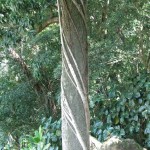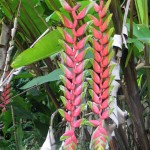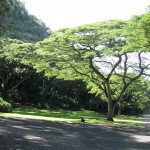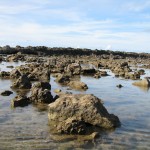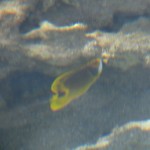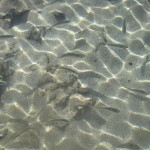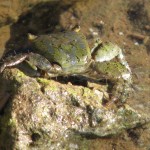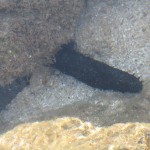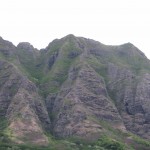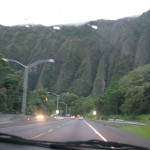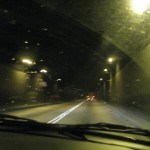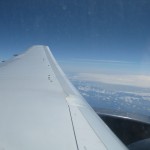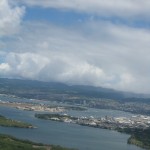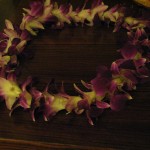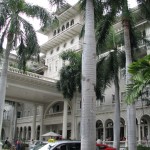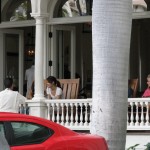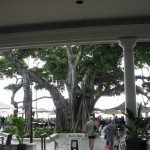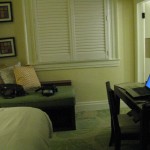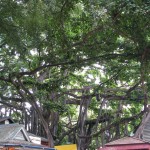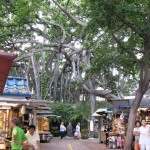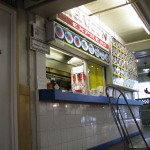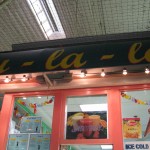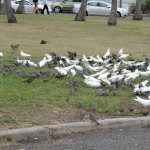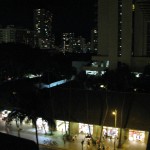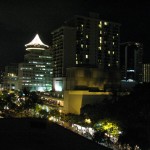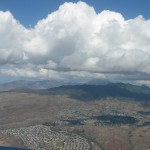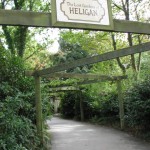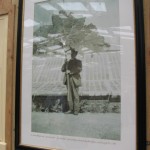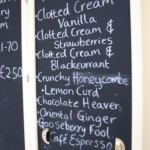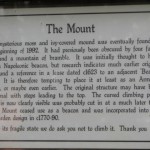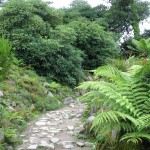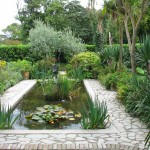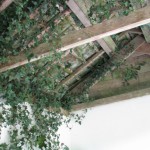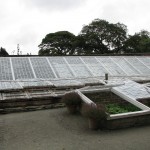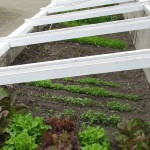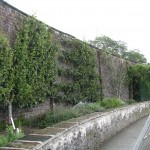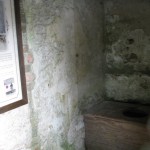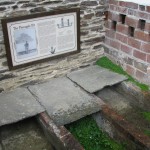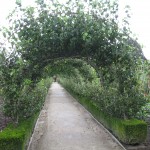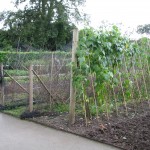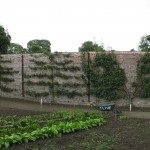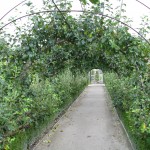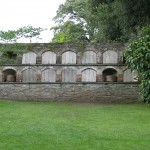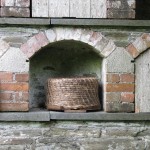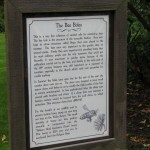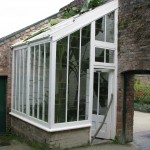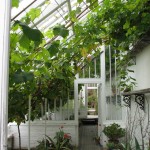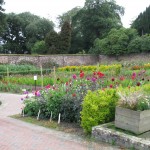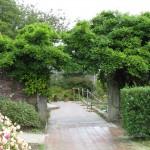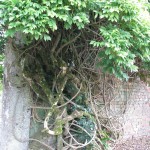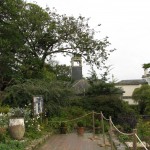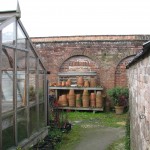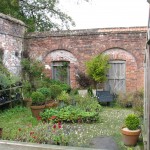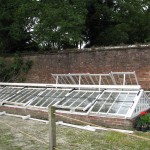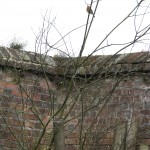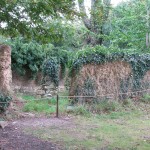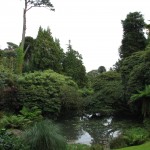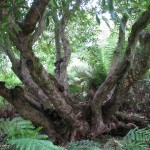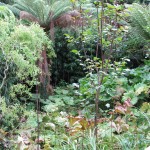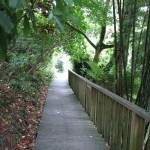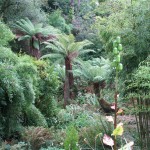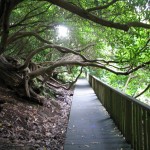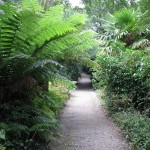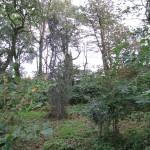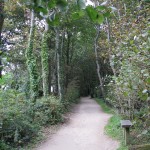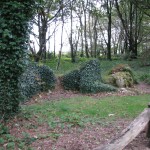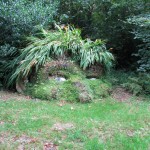-
Salton Sea

Salton Sea is a terminal sea; there is no connection to any other water Salton Sea is a terminal sea, created by accident in 1905 by a break in an irrigation canal from the Colorado River.

Trains a hundred cars long pass by regularly Salty and as it evaporates, becoming saltier, the sea hosts water sports, camping, and in the summer black flies by the millions, temperatures well over 100F, and the smell of rotting fish. However it is also one of the birding hotspots of the United States, as it is located along the Pacific Flyway in the Imperial Valley.

Black-necked stilt My daughter and I took advantage of the cooler post-Christmas weather and drove there last week. Winter is the best time to see birds and we weren’t disappointed.

Great egrets rest in the trees by the Visitor's Center The drive was a little over two and a half hours from our home, skirting the mountains and into the desert communities.The Sea is about 35 miles long, and is about 227 feet below sea level. The north-west part of Salton Sea hosts the visitor’s center and some good birding areas, but the best areas for us were about thirty miles south (it isn’t called a sea for nothing!) at the Sonny Bono Salton Sea National Wildlife Refuge, Unit #1.

Pelagic birds dining at Sonny Bono Fish die-off is a sad part of the life cycle of the mineral-heavy sea, and the sand is layered with the decomposing bones of millions of fish.
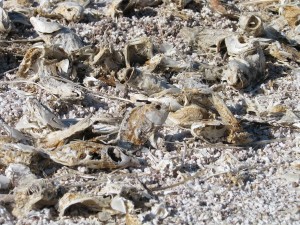
The sand is made of disintigrating fish bones Thousands of birds in enormous flocks can be seen all around the Sea. It is a grand thing to witness; it had been a common sight until fairly recently in US history to have flocks of birds so dense they blacken the sky.

Catching afternoon sunshine between feedings There weren’t that many there, but the numbers were amazing. In the southern part are agricultural fields where we saw hundreds of curlews and ibises feeding between the crops.
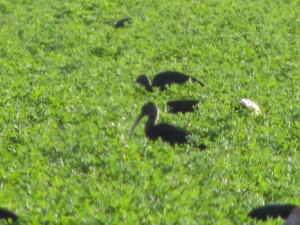
Ibis in agricultural fields. We were looking in particular for burrowing owls, and the advice we were puzzled to receive was to look in irrigation ditches and pipes along the road. Then, sure enough, as we were driving my daughter suddenly caught sight of one sitting alongside the road at the top of an irrigation ditch! He obligingly posed for many photographs. Later I saw two sitting at the opening of a pipe that protruded from an irrigation ditch! Amazing.

Burrowing owls nest in irrigation pipes One of the highlights for me was seeing sandhill cranes. These beautiful and majestic birds were feeding in ponds adjacent to flocks of pelicans. I didn’t happen to get any photos of them although my daughter did, because I was busy crawling under the car trying to find the source of the intense squealing sound that suddenly developed (only gravel in the wheel, thank goodness!) There were also hundreds of snow geese, and long strings of hundreds of red-winged blackbirds filled the sky as the sun set.

The only sound was the whisper of hundreds of blackbird wings overhead. We left, entranced, at sunset, and took the route home through the Anza-Borrego desert, up to 4,000 feet above sea level through the mountain town of Julian and back to Fallbrook in just over 2 1/2 hours. We covered about 275 miles that day, but it was well worth it for birding. The visitor’s center has many pamphlets on other birding areas in the vicinity, but they’d have to be done on other trips because there are just too many birds to see in one day!

The beautiful Gambel's quail Other birds we saw included Bonaparte’s gull, American Avocets, Stilt Sandpiper, Long-billed Dowitcher, and Gambel’s Quail, to name a few. An excellent birding site with Salton Sea bird list and locations is htttp://southwestbirders.com. Search for Salton Sea.
-
December in Fallbrook
Coots on the pond Sunlight in the sleeping willows. Tranquility (try not to look at the houses). Tough and determined roots being fed by decaying golden leaves. An impromptu Christmas tree: a snag decorated with juniper, cranberries and bird seed. Lush green weeds keeping a low profile in the winter. Stately sycamores; their leaves shed to keep their roots warm. A season of greens, golds and blues. Coyote bush seed fluff glowing white instead of snow. -
What I Did on My 50th Birthday
Waking up again in Oahu, I met my son for brunch at the Sheraton Waikiki. I was there last about 14 years ago with my young children and my aging parents, and for the first time about 39 years ago with my parents on a business trip. I remember the dining room because between the large glass panels that separate the outside from the inside, there is nothing… only space. No screen doors. House sparrows come and go, and there are no flies. It made such an impact on me when I was young, that concept of bringing the outside inside and the absolute freedom of having no bug or weather problem, that I’d always remembered that room but didn’t realize where on the several islands we visited it was until yesterday. The buffet caters to international tastes, so there is a Japanese area with miso soup, seaweed, tofu, pickled cucumber and plums, and many other goodies. There is a salad area, a cheese area, an area with assorted breads and freshly made pastries, the hot foods sections, fresh fruit and yogurts, and cereals. Throughout all this is the taste of the isles: fresh pineapple and papaya (it doesn’t taste as incredible anywhere else in the world), coconut syrup for the taro flour french toast, loco moco (egg on Spam on rice covered with brown gravy), guava juice, passionfruit pastries. There is no way to just eat a little, and no way to eat everything you’d like to.
Afterwards we walked along the beach back to the Moana, then drove out to the Manoa Falls rainforest, not far away. As soon as we got out of the car it began to pour. We purchased cheap rainjackets and mosquito wipes (don’t come to Hawaii without mosquito repellant!) and took the long, slippery, muddy and breathtakingly gorgeous hike up to the falls and back. The Manoa Arboretum is above and we walked around their pathways enjoying the incredible flowers. There are side trails up to the falls, and many pathways around the arboretum that we didn’t have time to hike. My son had to work at 5, so very muddy, we headed back towards town. We stopped at a Chinese restaurant and ate, then after leaving my son, I returned to my hotel. I was lucky enough to speak to my daughter for a long time, reply to many wonderful well-wishers on Facebook and a few emails as well. Then I dressed in one of my new Hawaiian dresses and walked with the crowds up and down the street, watching street performers doing magic tricks, balancing basketballs, pretending to be silver or gold statues, and playing electric violin to the radio. It was just the kind of day I’d hoped for. I spent it with one of my children doing something fun and adventurous, had great food, great exercise and a new start on life as I begin my next 50. Saturday, the 22nd I fly home.
-
More Oahu
As the time is three hours ahead of San Diego time, and being an early riser anyway, I’m up at 5 am with the dawn chorus. I’m able to walk out onto the beach in the dark, do my yoga stretches in the sand, swim a little in the man-made coves which create safe swimming areas away from the riptides, and watch the sun brighten the day. On Wed. we drove to the North side of the island, to Waimea Falls botanical park. An incredible collection of plants arranged in gardens representing the flora of different islands. It was very humid but lovely. We ate the now-warmed leftovers from dinner at the Cheesecake Factory in the car down the road at Shark Cove. There are incredible tidepools there. We waded, taking care not to slip on the craggy lava rock. I collected an impressive array of mosquito bites, but I”m always happy to contribute to local sustainability. Then we drove around the Eastern perimeter of the island, which is where the Hawaiians live. Incredible, majestic scenery. The mountains have real presence. When it looked as if we were going to drive around a curve directly into the mountain, there was the Wilson tunnel. Then we popped out to the other side with a completely different view, and on back to Waikiki. In the interest of time I’ll post the photos gallery style below.
Dawn Diamondhead as the sun rises in back of it Daylight reaches the hotels Paddleboarding, by the people who invented surfing Wailea Falls Monkeypod trees Water gardens Beautiful flowers Who says trees aren’t alive? Vines like a barberpole Heliconia Another beautiful ‘meadow’ Shark cove tidepools Parrotfish through the water Fishes and light Don’t worry, be crabby A sea cucumber or slug Yes, these craggy mountains are full of spirit What a backyard view for the native side of the island! I didn’t know it, but we’d be going under these mountains! Watch a video going the other way at http://www.youtube.com/watch?v=J671kJA_HRo Sunset on incredible mountains -
Traveling Again: Oahu

Oahu from the air I’m visiting my son in Oahu for a few days… good excuse, huh? After some of the usual flight and traveling difficulties, and some very welcome sleep, I’m sitting in my pre-dawn hotel room listening to the morning chorus of birds and Waikiki traffic. This is my fifth time visiting the isles; my third here. All over the hotel, the beach, the vendors is a memory of being here with my parents at various stages of our lives. My mother loved Hawaii so much. So different from shoveling snow in New Jersey layered in sodden cold clothing. If she had more than one life to live I’m sure she and Dad would live on Maui. I was here last with them when my children were small, just after my divorce. It feels like a hundred years ago. As it is, I’ve left the mainland as a woman who is forty-something, and returning a fifty year old. I need the warm scented breezes to cushion the impact.
Waikiki is like any American resort: expense and commercialism and pretense of class turning its back on the dirt, pollution, noise and poverty that seeps through cracks from the other side of the International Marketplace just across the street. Tourists shouldn’t roam far at night. Making Hawaii a state did it no favors; I agree with the natives that they’ve lost so much. Next time that I visit it will be to a bed and breakfast in the hills where there is greenery, birds and quiet.
Today we’ll go to one of the beautiful areas of the island and see some of that incredible nature that clings on to this poor volcanic rock. Hike and birdwatch and listen to the lack of human machines, if possible. Feel the freedom of not being in competition with slender young women, for at my age I am invisible, which is comforting. Let the scent of the flowers seep inside. Enjoy the company of my son as an adult. Here are a few photos of my first afternoon here:
A very long airplane wing, with Oahu below Pearl Harbor from the plane Orchid lei The historic Moana Surfrider Rockers out front Old Banyon tree in courtyard of hotel My room at the Moana Surfrider Banyons Banyon trees at the International Marketplace Where I bought a tofu spring roll snack Hu-la-lu ice cream, featuring pineapple, coconut and other tropical flavors Birds, mostly invasive species, feeding on seed in a park Waikiki and Honolulu Waikiki and Top of Waikiki revolving restaurant Oahu from the air -
To Land’s End

The Land's End Hotel This will be the last of my Cornwall travel experiences: Land’s End. At the very south-west tip of Cornwall is Land’s End. When you stand at the clifftop of Land’s End and face west, the next main body of land is the east coast of the United States.

No main land until the USA It was astoundingly beautiful, with cliffs full of history, danger and excitement. We stayed at the Land’s End Hotel (http://www.landsendhotel.co.uk/) which perches at the edge of the cliff.
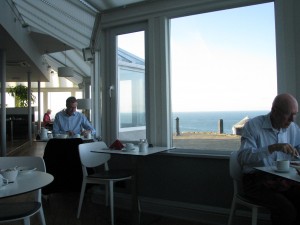
Breakfast in the dining room with an incredible view 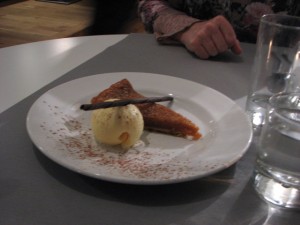
Treacle Tart... yum! The dining room windows and our room window faced the ocean and the setting sun.

Sunset over the Isles of Scilly From the hotel you could see a small group of rocks and a lighthouse.
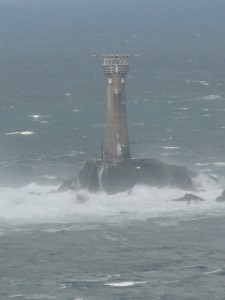
Many a sailor's saviour I watched both the moon and the sun set every day we were there.

The moon setting pre-dawn from our room On good days you can see the outline of the Isles of Scilly, which we regretfully didn’t have a chance to visit. Although we still were buffeted about by the remaining winds of the hurricane the weather was beautiful.
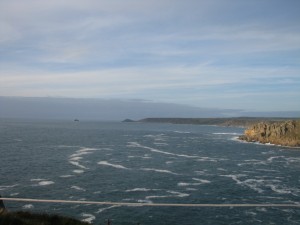
Wind-tipped waves In Cornwall they say that if there are clouds on the horizon it is going to rain, and if there aren’t then its raining already. We had some predictable showers, most notably in the morning, but nothing to complain about. And the sea… oh, the sea! We spent our last morning there walking the cliff paths between rock and heath, which even in September were quilts of purple and yellow flowers.
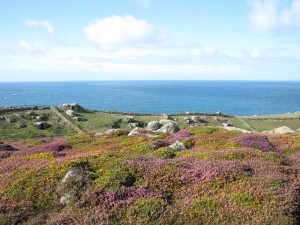
Gorse and heather in glorious bloom The rock breaks into large chunks rather than crumbling away, which creates massive natural sculptures on which you can imagine giants of legend sitting, chin on fist, mesmerized by the waves.
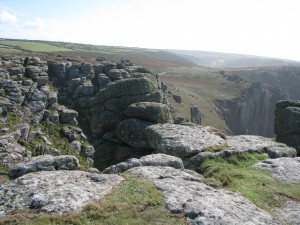
Rocks like giants' chairs The relentlessly pounding surf formed caves which made the waters home to smugglers.
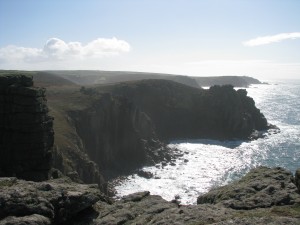
These be smuggler's waters! 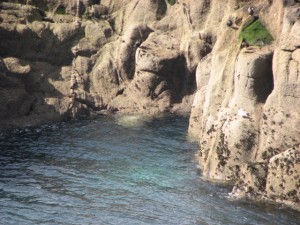
Natural caves were great for smugglers The giant rock cliffs formed enormous tombstones for the countless sailors of countless ships, all foundered on the hidden stones by wild tides, since man first took to the sea.

No guardrails on the trail to disturb the beauty The cliff pathway followed the edge without restraints or hand-holds of any kind, and it led all the way to the historic southernmost town of Mousehole (pronounced MOWzzle).
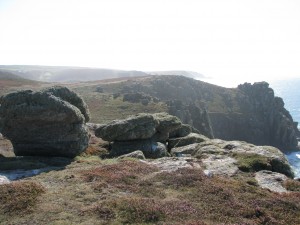
The cliff path leads several miles to Mousehole Although the wind kept the number of birds low, there still were the pelagic inhabitants using the cliffs for protection and warming themselves in the sun.

Seabirds resting 
Rocky islands are perfect for seabirds A RSPB (Royal Society for the Protection of Birds) center sat in the hotel complex on the cliff from where my daughter sighted a peregrine falcon.

RSPB Center, with an inviting Blue-footed Booby at the entrance The area around Land’s End is mostly empty, with a few farms and another historic hotel The First and Last (depends on which way you are going!) which boasts of a smuggler’s tunnel to the sea and the horrible end of the woman who turned them in to the Crown.

Epitaph for a squealer There are people who travel from Land’s End up to the farthest point on mainland Britain, John O’Groats, and call themselves End-to-Enders. Many do it for charity; some walk or bike. When we visited Scotland several years ago we took the ferry from John O’Groats to the Orkney Islands, so we’ve been at each end, just not in direct line. This Cornwall coastline is the most dramatic I’ve ever seen.

Incredible colors and textures I left part of my heart in Cornwall; something in the heartiness of the people and creatures that live there, braced against the wind and weather, calls to me.

A tough bunny I could have spent days like the giants, staring out at the roiling waves, watching the next storm blow in.

Mesmorizing As long as I could be inside nice and cozy when it hit! I want to thank my daughter for the use of many of these photographs, and for being such a good traveling companion and navigator.

Sunset -
St. Michael’s Mount

St. Michael's Mount Back to travel photos! While in Cornwall, we had to go to the coastal city of Penzance (because one of our favorite Gilbert and Sullivan plays is, of course, The Pirates of Penzance). From there we walked to the neighboring city of Marazion (don’t do this… drive!) to see St. Michael’s Mount http://www.stmichaelsmount.co.uk/ . From about 350 BC the Mount was a place where much trade took place, especially in local tin. Smuggling, too, I’m sure. Then in 495 AD some fishermen saw on the rocky island the vision of the angel St. Michael. Not long after a chapel was built and religious pilgrams flocked to the Mount.

An imposing structure A priory joined the chapel and the old, glorious castle appeared, jutting out of the hard stone and overlooking everything. Although a place of worship, many times in its history did the Mount have to take arms. Most notably it was from St. Michael’s Mount that the first beacon light was lit to warn of the Spanish Armada.
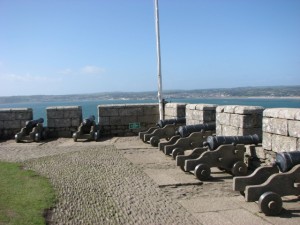
At some times the priory saw battle. After the Dissolution, it was purchased as the home of the St. Aubyn family, which it has remained ever since. In the 1950’s one of the family gave the structure into the hands of the National Trust, with the codicil that the family could live in it for 999 years. What makes St. Michael’s Mount very special is that it can be walked to across a causeway when the tide is low; when the tide covers the cobblestones, it becomes and island. We’d come to know about the causeway as it was used the in movie version of Shakspeare’s Twelfth Night.
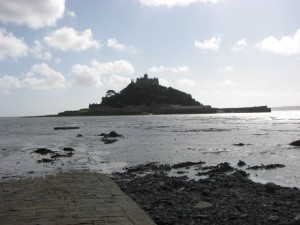
The causeway underwater We walked across the ankle-twisting cobbles to the imposing and ancient fortress.

A ruined gatehouse, with the causeway far below. We were still experiencing the very heavy winds from Hurricane Irene, so at times sand blew into our faces and it was a little hard to stand. Otherwise it was a clear and gorgeous day. Although still a private residence most of the castle can be toured.
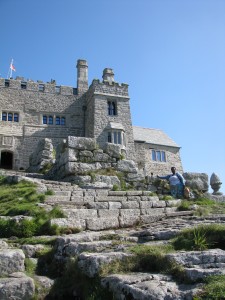
The 'front door' of the castle, facing west. 
Legend has it that a giant once lived on these giant stones. There is a grand library, and the place is rife with window nooks with the most incredible views of the English Channel.
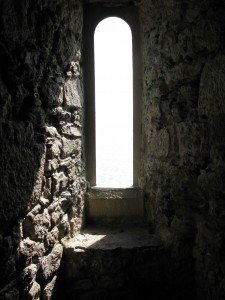
A stony window seat. The amount of labor that went into building these stone fortresses,
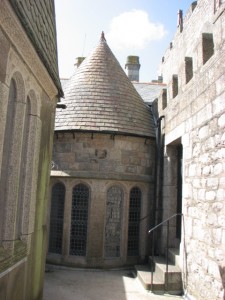
Beautiful and centuries-old workmanship. to make them last for centuries, always amazes me.

At the top of the priory The chapel boasts a rose window dated from the 15th century,

The Rose Window in the chapel as well as other fantastic artworks.
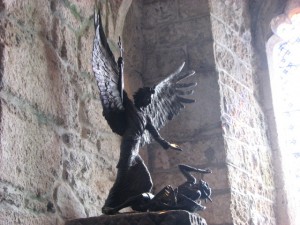
Artwork in the chapel In every room there are displays of beautiful handicraft,

Ornate sugar spoon and some unusual furniture.

An unusual chair Below the castle are sub-tropical gardens, which were closed the day we were there. We peered down at them and discovered… a good portion of the plants we have here in San Diego!

A view of a window nook, the gardens and the Channel. 
The sub-tropical gardens in temperate Cornwall When we were to leave, the water had just begun to cover the causeway. Some souls were crossing but getting their feet wet as the winds brought the tide in quickly. We waited for a boat ride and for only one pound fifty pence (!) each, we could achieve the mainland!
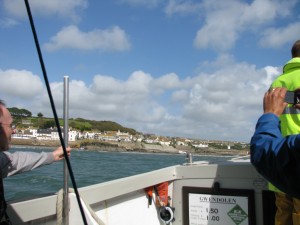
Heading back to shore. The water was choppy but we were with people who joked a lot, which we often found to be true in our British travels, and that made the crossing fun. There are festivals held on the Mount, along with re-enactments and garden tours. Check their website for announcements if you plan to visit, and keep an eye on the tides!
-
The Lost Gardens of Heligan
If you ever go to England, go to Cornwall and spend at least a day at the Lost Gardens of Heligan (http://www.heligan.com/ ). Due to a flat tire we only spent four hours there and we didn’t see even half of the 400 acres of incredible restored gardens. The story is this: a thousand acres on the southern coast of Cornwall has belonged to the Tremayne family for about 400 years. At the end of the 1800’s, one of the Tremaynes had built extensive theme gardens. There were walled gardens, enormous hedges, glass houses, cold frames, a pineapple pit where the only pineapple grown in Cornwall grew warmed by horse manure. Melon houses, leisure gardens, formal flower gardens, woods, kitchen gardens and unbelievably, tropical gardens, filled the estate. Due to Cornwall’s position by the English Channel the climate is such that with care tropicals can be grown there. The estate was fantastic; then came WW I, and almost half the family and staff were killed. The gardens were abandoned. Subsequent wars and taxes took their toll, and the gardens became overgrown. Vines, brambles, trees and weeds ran rampant, breaking through the glass roofs, pulling apart brick walls, upsetting carefully laid pathways and covering every trace of the gardens under a head-high blanket of tangled, thorny brush.
Twenty-one years ago, the Tremayne who inheirited the gardens, asked one of the founders of the neighboring Eden Project ( http://www.edenproject.com/ ) to try and restore the gardens. The task was phenomenal and reads like a mystery. Hacking through the overgrowth they found the walls, the foundations and the clues as to what had been. Since then the gardens have been restored. They are everyone’s dream of a garden combined. There is a mound that was a beacon mound during Nepolianic times, but then discovered dates back to the Armada, and then back to Medieval times! There is a jungle with massive gunnera plants and palm trees, about half an acre of vegetables all grown from seed that dates from the late Victorian time, walled flower gardens, ‘antique’ poultry and cattle, unique sculptures recently added, and a wildlife garden to encourage the existence of so many insects, birds and animals that are disappearing. Even with weeding through photos I came up with so many that I want to share, that I’ll just post them below. Visit the website and read up on the Lost Gardens, voted Britain’s Finest Gardens. They are magical.
Entrance to a magical world. The Tremayne who built the gardens holding a single Gunnera leaf in front of his famous pineapple pit. Flavors of ice cream… we didn’t get to have any! A mysterious mound was uncovered and thought to have been a beacon site in Nepolianic times, and for centuries beyond that. Stone steps into the ravine The Italian garden Ivy coming through the roof, trying to reclaim the building once again. Hot houses and cold frames Cold frames for veg. Espaliered pears of many varieties. Writing on the wall of the ‘thunder room’, or original composting toilet All plants and veg grown are from the late Victorian period Espaliered fruit trees make use of warm wall space About a quarter acre of mixed greens. Bee skeps (baskets, pre-movable hives) were kept in boles for winter protection. A bee skep in a bee bole History of the Bee Boles A banana grows in Cornwall! Melon houses Potting shed with greenhouses in a walled area. Sigh. Cold frames in the potting shed A robin watches, just like in The Secret Garden The overgrown remains of mud brick walls A very steep pathway lined with chicken wire to prevent slipping The Jungle A wire sculpture of a woman with her arms out… can you see her? A deciduous walkway Mud Woman A very green man -
Jamaica Inn

Our first room was above the pub on the left. I know you are all sick of reading about bathing a hen; I’m back from a vacation in Cornwall, UK and helping my daughter move back to OSU for her Junior year. With a gazillion photos to sort through, I’ll do my best to show you the highlights of our travels as well as keep you up on the growing of my gardens.
Why Cornwall? It is a land of legend, infinite beauty, the birthplace of many famous people, and is home of the pastie (a turnover with savory filling made by wives for lunch for their mining husbands). It was also supposed to be the warmest place in the UK in September, and the best place for birding as all the migrants fly near there. What no forecasting website let me know was that the hurricane that had hit the US East coast had moved north near Ireland, and gale-force winds were hitting most of upper Europe. Cornwall was no exception. The winds hit on the third day of our trip, and let up towards the end, so birding wasn’t so great ( you had to look quickly :). )
Our first lodging in Cornwall was at the Jamaica Inn (http://www.jamaicainn.co.uk/ ). How great is that! For you literary types, or those who love Alfred Hitchcock films, you’ll recognize this Daphane Du Maurier title which had been made into a movie. (Hitchcock also made movies of two of her other works, Rebecca and The Birds).
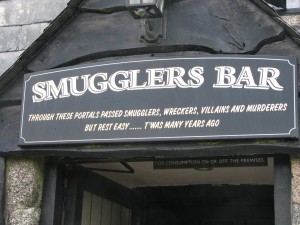
The Inn had been infamous for smuggling Jamaica Inn sits on the Bodmin Moor in East central Cornwall. When we flew into Newquay (pronounced NEW-key) airport and rented our car it had just begun to rain with a little thunder thrown in for atmosphere. The drive through traffic was slow (the highways have cow crossroads with signal lights!) and as we approached the Inn the fog rolled in.

The museum in the rain. There had been an accident on one of the highways so traffic was backed up. As we gratefully parked in the main parking lot of the Inn, an older man in a yellow traffic vest that had been out on the street came over and suggested that we park in the small lot in the front. He explained about the traffic, and joked about us being ready to meet ghosts at the Inn. I told him that with a meal, dry clothes and a warm bed, let the ghosts do their worst! He laughed and replied that ‘strange things happen around there.’ I moved the car, navigating a forty-five degree turn in a narrow, brick sided gate without scratching the car (England is infamous for this sort of thing), and re-parked. Glancing back at the road, I noticed that the man had disappeared. We never saw him again! Strange things, indeed.
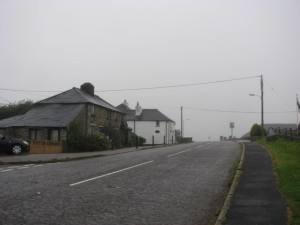
The neighborhood isolated by fog In three nights we stayed in three different rooms because of the Inn being full.

Main entrance We moved from the smallest and oldest room, one which the owner vowed had the most ghostly activity, to a larger, slightly less ghostly room, to finally a large room in the ‘new wing’ with a great view of the Bodmin Moor. The staff knew us as the ‘traveling Americans’. The owner told us that only the night before the guest in that first room had stood up from the bed and felt a hand push him back, twice. We walked through the dark pub, up the winding stairway to our room, named after one of the characters in Du Maurier’s book, and entered our room. It could very well have been the source of many unusual phenomenom. Being in the old section, which dated back 400 years, the floor slanted inward so much that you could imagine yourself shipboard stuck on the roll of a wave. It was great. After a visit to the pub, I don’t doubt that the previous guest had fallen down.

A man who disappeared on his birthday on the moors. The Inn is hundreds of years old, and definately has an atmosphere.

Original stonework and chains At the Rancho Guajome Adobe in Vista, I havethe feeling that the house is like an older woman who was dressed in her finest, hair done up, back straight and proud, welcoming guests to yet another party at her fine home. At the Jamaica Inn, with its slanted floors, swaybacked roof and settled walls, I had the impression of an old, mostly toothless hag, one eye squinty, the other pierceing you with its gaze to see what you’re worth, and cackling at your dismay when you shudder. Wonderful!

Dining in the dark; makes you want a mug with a glass bottom! There was a microclimate that surrounded the Inn; it was always colder, foggier, rainier and windier than even the coastal areas both North and South. We’d awaken to crummy weather and defiantly brave it to visit a garden or ruin, and find the weather a lot better once we left the area! Our last night there was the beginning of the intense gale-force winds. Flag poles were outside our room and they beat a strong tattoo all night. In the morning I pushed the window open against the wind to have a look, and wasn’t surprised at the flag that had beat so furiously in the storm.

The Jolly Roger The moor is not the wild, heath-covered marshy area one would expect anymore. It has been cut into squares for farmland, lined with hedgerows or stacked stone walls. It still is beautiful. The radiant green of British and Irish fields can’t be explained, just loved.

Bodmin Moor through our window. We didn’t have time to hike to the standing stones there, and tried twice to walk to the Dozmary Pool, the legendary home of the Lady of the Lake who kept King Arthur’s sword. We had heard that the ‘bottomless lake’ of legend does, indeed, dry up, and there is another lake that claims the sword as well, so we didn’t feel too badly about missing it. We walked across a field, sinking into wet spots, imagining Jane Eyre collapsed on a moor, and all the other stories and legends surrounding these fascinating places. I was glad to be close to safety!

Yes, that's fog behind the museum The Jamaica Inn does brisk business as a tourist stop, particularly for busloads of ghost-seekers. They visit the Du Maurier museum, the gift store, and have lunch in the dark pub.
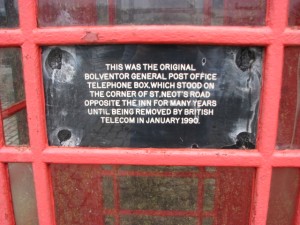
On the telephone booth, the only spot of color in the courtyard. There are figures from the book lurking the corners, some of which speak to you when you press a button, and stocks in the front yard.

The harried heroine of Jamaica Inn, and touch of Poe with the cask of Amantillado A ghost log sits next to the guest register for reporting any supernatural activity, and it is quite full.
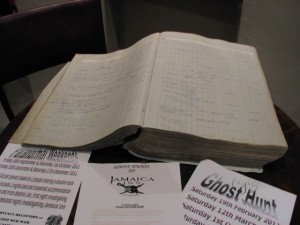
The ghost log I was mildly disappointed in not being spooked; however, if any ghost had tried to wake me up they would have been disappointed, for I was too tired to care!
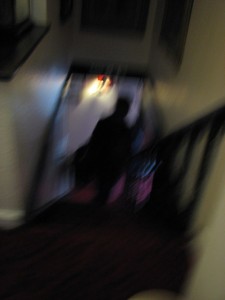
Spooks! Any adventure is enjoyed even more after you are safely home. I loved staying at the Jamaica Inn, soaked up the atmosphere, the grey stones the fog and all the corny spooky stuff set around the Inn. The name Jamaica Inn allegedly came from all the rum that was smuggled through. A plaque on the floor of the bar commemorates a spot where someone had been murdered. I wouldn’t have missed staying there for the world!
-
Top Ten Air Travel Tips (for now, anyway!)
In the last four years I’ve done a little traveling. I’ve flown and drove in England, Scotland and soon Cornwall, and flown to tour Ecuador and the Galapagos Islands. Also I’ve been traveling back and forth to Oregon to see my daughter in college. I’ve learned a few tricks; I’m sure I’ll learn more the hard way each time I travel. Here are ten tips that I find useful and perhaps you may, too:
1. Don’t rely on travel agents to do the right thing.
For my first vacation four years ago, I made a trip to my AAA office. Since I was traveling to England, they couldn’t help me except for booking the plane flights. I looked into all kinds of tours, and finally gave them all up and booked our lodgings, rented a car and off we went under our own sails. We stayed at interesting places and received good rates, too. However, the travel agent booked our return flight to the US and the connecting flight home so closely together that it didn’t take customs into consideration and our flight was gone long before we even collected our baggage (which also goes through customs.) Fortunately it wasn’t one of the major flights. Look online and find the configurations of the airports, and see how far it is to get from one terminal to another, especially if you must switch airlines. Remember that you have to check in at the desk when you change airlines, even if you’ve been ‘checked through’ at the beginning. Otherwise your luggage will be enjoying a tour of your destination while you await another flight. I overheard one woman frantically calling her travel agent because her plane landed in San Diego but her connecting flight was booked from Carlsbad airport, and she didn’t know. After a frantic and expensive taxi ride she found the plane was late, which made everyone miss all connecting flights. She wasn’t happy.
Also when booking online through TripAdvisor, Expedia, Travelocity, or any of the other dot-coms, keep comparing. TripAdvisor compares costs of flights from many different organizations, but try going through the airline’s website. For my upcoming trip to Cornwall, TripAdvisor came up with roundtrip for two at over $5,000. I almost dumped the whole trip. I went outside, visited the chickens, cooled off, then came in and checked United, where I have the Mileage Plus program. The trip came out to roughly $2500. Still a lot of money, but half of what had been proposed. Plus I earn mileage for the trip which I can use when booking flights to and from my daughter’s university. If you want to do it right, do it yourself! The best laid plans can go awry with one late plane or a little fog over San Francisco (I try to avoid changing planes there), so go with the flow.
2. Bring dental floss
When we went on an 8-day boat tour of the Galapagos Islands, something inextricable wedged in my teeth. On a small boat for eight days, I had no way of obtaining floss. My gum swelled and was distracting. I wish I had brought dental floss. Besides its regular use, dental floss is strong enough to be used as string or thread to tie up or on errant clothing, luggage tags, bandages, and much more. Plus it has its own built-in cutting device that isn’t considered a weapon.
3. Leave lots of time to switch terminals.
If you have an International flight, you will probably have to go to a different building entirely than the domestic flights. You’ll probably have to not only walk a great distance with your luggage, but take a tram to the other building. It can take 45 minutes from gate-to-gate if you are a fast walker and the tram isn’t full, and then you must check in at the desk and deal with your luggage again. So when booking your flight, make sure you leave a lot of time between flights.
4. Read reviews of airports.
Often when you book flights online, the information given is a pack of lies. Reading reviews of the airports and flights may give you tips about surprises that would have completely messed up your trip. For instance, a flight into England with a connecting flight to somewhere else in Britain may not even be at the same airport, and the fine print or initials may escape your notice. In fact, for many flights you must travel from Heathrow to Gatwick airports, and reviews say that with traffic it could take a couple of hours to travel, plus going through customs, gate check in, etc. Some flight packages say there are only one or two stops, but actually there is a third hidden one where you must deplane and board another. This happened in Bogotá, Columbia on the way to Ecuador. Machine-gun –bearing, camouflaged soldiers stood guard all throughout the airport since it is such a hotbed for drug smuggling.
5. Pack as little as possible, under 22 lbs.
You really don’t need to bring much: you aren’t moving. Bring a bar of soap for washing yourself and your clothing and invest in some good travel clothing that dries quickly. An excellent way to dry wet clothing is to lay it flat on a towel, roll the towel up, then with a partner or by stepping on one end, wring the towel as hard as you possibly can. The clothes inside will be just barely damp and will have a better chance of drying overnight hung out in the bathroom or over the heater in the room. By packing light clothes and washing often, you can get away with a small rolling suitcase and another small bag or purse or backpack, neither of which need to be checked as luggage. Keep the weight of a bag to 22 pounds or under if you will be traveling on small aircraft because many have weight regulations. Leave a little leeway for souvenirs on the return trip. Besides, waiting for your luggage to magically appear can add half an hour or more to your airport time, and if your luggage is lost, getting it back can be chancy.
6. Switch to solids or powders if possible; use tiny plastic bottles for everything else.
Liquids must be in containers no larger than 3 oz, and all liquid containers must fit neatly in a sandwich bag. I have no problem with security regulations because that is what must be done to try and protect us from the crazies. To make life easier when traveling, use creams, solids or powders when traveling to keep the liquids to a bare minimum, and transfer any liquids into small plastic travel bottles that you label clearly and put tape over.
7. Put all pharmaceuticals into plastic zip-lock bags, liquid or not.
Something will spill. Count on it. A lid will pop off or something will break, and then toothpaste will be all over your jeans, or nail polish all over your medications. I put soap and razor in one plastic baggie (the soap will be wet when I put it back in), medications, bandages, Imodium, travel sickness pills, daily small baggies of vitamins or daily medications, and any other dry stuff, into another plastic bag. Toothbrush and paste and floss go into another. When in the hotel, I put the bag with the soap in the shower, the bag of toothbrushes by the sink, and the other bags on the counter so everyone with me can get at them. It is so easy to pack up and keep anything wet or breakable from contaminating everything around it. I have also been told that putting your passport, license, and money into a plastic zip bag is a wise thing to do, so in case you survive a crash landing in the ocean, getting home will be very easy because all of your important things have been waterproofed. I haven’t done that. I’m taking my chances.
8. Be polite and kind to airline personnel, particularly those at the gate.
What an awful job! As bad as working at the DMV. These people are smiling through gritted teeth while being insulted and harassed and cursed at by people who are suffering through their travels. These scapegoats have loved ones and sore feet and car trouble, just like everyone else. Be nice to them with a smile, especially if they are grumpy looking. They are probably that way because the last guy just made life hell for them.
9. Drink lots of water.
By the time your body tells you it is thirsty, you are already a little dehydrated. Travel dehydrates the body. Drink lots of water, even if you need to squeeze down the aisle and cram yourself into the tiny lavatory because of it. All those germs your body is trying to get rid of will be washed away better, your digestion from the strange food will be eased, and swelling and aches from sitting so long won’t be so severe when you have adequate water in your muscles. Tea, coffee and alcohol dehydrates, so drink pure water.
10. Bring your own food.
It is no longer a given that you will receive a meal on a flight, or even the so joked about packet of peanuts. Many flights offer nothing, or just beverages, or have a selection of horrible foods to purchase. Often boxed lunches include a cold sandwich, a packet of salty pretzels or chips, a packet of cookies, and more condiments than you could ever hope to use. Being vegetarian, it is very difficult to eat adequately on long flights that don’t offer standard meals. However the vegetarian food when we do get it has been pretty good, all-in-all. Since I used to travel with children and with my mother who needed to keep her blood sugar up, I’m used to baking small muffins or sandwiches the day before the trip. I try to make things that will last several days. Even after reaching our destination we’ve resorted to eating our snack foods for several days between meals. For most people who are used to fast food and eat meat, it is easier to buy from one of the stores at the airport and carry it onboard, but I find home cooked food helps keep tummies stable.
Hopefully these tips can help if you aren’t already familiar with them. If you like to travel, don’t put it off. See what you want to see while you can. Time flies, and so should you.

